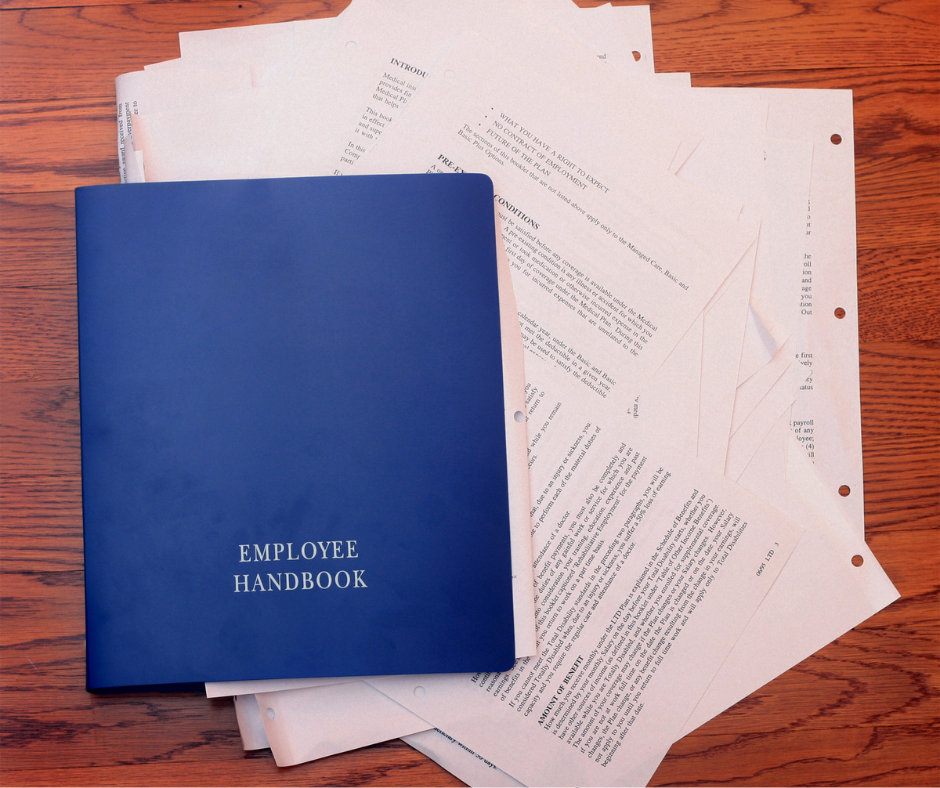
Employee Handbooks are important documents that provide essential information to employees regarding company policies, procedures, and expectations. However, using another word for an employee handbook can have several advantages. It can enhance accessibility and understanding, create a positive image, and tailor to the company’s culture. Some possible alternatives for an employee handbook include Employee Guide, Employee Manual, Employee Handbook Toolkit, Employee Playbook, and Employee Policy Guide. When choosing the right term, considerations such as company language and terminology, tone and purpose, and employee engagement and branding should be taken into account. Finding an alternative term for the employee handbook is crucial as it can better represent the document’s purpose and resonate with employees.

Definition of an Employee Handbook
The employee handbook is defined as a document that provides the definition of an employee handbook. This document outlines the policies, procedures, and guidelines of an organization regarding its employees. It serves as a guide for employees to understand their rights, responsibilities, and expectations within the company.
Employee handbooks play a crucial role in establishing clear communication and promoting consistency across the organization. They serve as a centralized source of information for employees to refer to when questions or issues arise.
In addition to the definition, an employee handbook also includes important details such as the company’s mission, employment policies, workplace conduct, benefits information, and procedures for addressing grievances or conflicts, all of which collectively guide an ideal employee in understanding and adhering to the organization’s values and expectations. It may cover additional topics like performance expectations, attendance policies, and safety guidelines.
The purpose of an employee handbook is to create a transparent and fair work environment by defining the various aspects of the employment relationship. It ensures that employees are aware of their rights and obligations and establishes consistency in policy enforcement.

Why Use Another Word for Employee Handbook?
Looking to revamp your employee handbook? Discover the power of using another word for it! In this section, we explore the reasons behind embracing alternative terms for employee handbooks. From enhancing accessibility and understanding to creating a positive image and tailoring to your company culture, we’ll uncover the numerous benefits that come with a fresh perspective on this essential business tool. Say goodbye to the mundane and reimagine your handbook’s impact!
1. Enhancing Accessibility and Understanding
Enhancing accessibility and understanding in an employee handbook is of utmost importance for effective communication and compliance. It is crucial to utilize clear, concise, and user-friendly language, along with organizing the information, in order to ensure that employees can easily access and comprehend the content. To achieve this, the following strategies should be considered:
1. Use plain language: Steer clear of complex jargon and legal terms. Instead, opt for simple and straightforward language that is easily understandable by everyone.
2. Organize the information: Present the content in a logical manner, utilizing headings, subheadings, and bullet points to break down the information into manageable sections.
3. Provide examples and case studies: Employ real-life examples and case studies to illustrate important concepts and policies, thereby assisting employees in applying the information effectively.
4. Include visuals: Incorporate infographics, charts, and diagrams to convey information more effectively. Visual aids can aid employees in processing complex information and remembering key points.
5. Use a user-friendly format: Consider utilizing an online platform or digital tool to make the handbook easily accessible and searchable. Incorporate a table of contents and a search function to facilitate efficient navigation for employees.
6. Regularly update the handbook: Ensure that the handbook is kept up to date with any policy or regulation changes. Inform employees about these updates to ensure that they always have the most current information.
By implementing these strategies, accessibility and understanding in the employee handbook can be enhanced, thereby promoting compliance and fostering a positive employee experience.
2. Creating a Positive Image
Creating a positive image is important when choosing an alternative term for an employee handbook. The language and terminology used can greatly impact how employees perceive the company and its policies.
One option is to use the term “Employee Guide.” This term suggests that the document is a helpful tool, providing guidance and support. It portrays the company as invested in the success and well-being of its employees.
Another alternative is “Employee Manual.” This term conveys professionalism and organization, indicating clear policies and procedures. It gives the impression the company values consistency and clarity.
Consider using “Employee Handbook Toolkit.” This term suggests a comprehensive resource that empowers employees to navigate policies and procedures effectively. It conveys support and provides employees with the tools they need.
“Employee Playbook” can also create a positive image. It implies policies and procedures as a game plan for success. This term suggests the company values teamwork, strategy, and achievement.
Lastly, consider “Employee Policy Guide.” This term emphasizes the importance of policies and procedures. It suggests the company takes compliance seriously and strives for a fair and transparent work environment.
When choosing the right term, consider the company’s tone and purpose. The language used should align with the company’s values and culture to create a positive image. Also, consider how the chosen term can enhance employee engagement and contribute to the overall branding of the company. A well-chosen alternative term for an employee handbook can shape a positive company image and foster a supportive work environment.
3. Tailoring to Company Culture
Tailoring an employee handbook to company culture is crucial in enhancing engagement and promoting a positive work environment. When tailoring the handbook, some considerations to keep in mind are reflecting the company values, using language and tone that resonate with the culture, aligning policies and procedures, and promoting inclusion and diversity.
A great example of successful tailoring can be seen in Company XYZ. They created an employee handbook that accurately reflected their values of transparency and empowerment. The handbook incorporated a conversational tone and inclusive language, which greatly emphasized collaboration and flexibility. This approach resulted in a significant boost in employee engagement and played a significant role in establishing a strong company culture.

Possible Alternatives for Employee Handbook
Looking for alternative options for your employee handbook? Say goodbye to the traditional “employee handbook” and explore these exciting alternatives. Discover the Employee Guide, Employee Manual, Employee Handbook Toolkit, Employee Playbook, and Employee Policy Guide. Each sub-section will open doors to innovative ways of presenting policies and guidelines to your employees. No more boring, static handbooks – it’s time to revolutionize your approach to employee resources and engagement. Let’s dive in and explore the endless possibilities!
1. Employee Guide
When it comes to providing information and guidance to employees, an employee guide is an invaluable tool that enhances accessibility and understanding in the workplace. The employee guide serves as a one-stop resource for employees to find clear and concise information about company policies, procedures, and expectations. This promotes consistency in communication and ensures that all employees are aware of the company’s policies and guidelines, promoting fairness and consistency across the organization.
During the onboarding process for new hires, the employee guide plays a crucial role in familiarizing them with the company’s culture, values, and expectations. It empowers employees to find answers and solve problems independently, reducing dependence on superiors and promoting autonomy.
Employee guides have been used for decades to provide essential information and resources to employees. Companies have recognized the importance of comprehensive guides that cover various employment aspects, including policies, benefits, and procedures. With technological advancements, employee guides have evolved from printed booklets to easily accessible digital resources. Even today, employee guides remain indispensable for efficient communication, consistency, and clarity in organizations.
2. Employee Manual
An employee manual is a crucial resource for organizations to provide clear guidance and information to their employees. It outlines company policies, procedures, and expectations.
When utilizing an employee manual, there are several key aspects to consider:
1. Accessibility and understanding: It is important that the manual is easily accessible to all employees, whether in physical or digital format. Moreover, it should be written in a clear and concise language that can be easily comprehended.
2. Creating a positive image: The employee manual presents an opportunity for organizations to showcase their values, culture, and dedication to their employees. It should accurately reflect the company’s brand identity and present information in a positive and captivating manner.
3. Tailoring to company culture: It is essential for the manual to align with the unique culture and values of the company. It should incorporate language, tone, and style that resonates with employees and accurately represents the company’s identity.
By considering these factors and utilizing the term “employee manual,” organizations can develop a comprehensive resource that effectively communicates company policies and expectations while staying true to their culture and values.
3. Employee Handbook Toolkit
Employee Handbook Toolkit: A comprehensive set of tools designed to assist in the creation of an employee handbook. This toolkit includes a variety of templates, forms, and resources that can be customized to meet the specific needs of your organization. It offers step-by-step guidance to streamline the process and save valuable time.
Additionally, it provides examples of best practices and legal requirements for ensuring compliance and reducing risk. The toolkit can be accessed online or in a digital format, allowing for easy updates and modifications. It also features helpful tools such as checklists, sample policies, and interactive features to enhance the user experience.
Furthermore, this toolkit encourages collaboration and input from various stakeholders, ensuring that the final product is comprehensive and inclusive. When selecting an employee handbook toolkit, it is important to consider factors such as company size and complexity, industry-specific requirements, customizability, user-friendly interface, as well as the availability of updates and support.
With the Employee Handbook Toolkit, you can confidently create a well-crafted employee handbook that meets all your organization’s unique needs.
4. Employee Playbook
The employee playbook is a vital tool for companies to provide guidance, set expectations, and outline procedures for employees. It is essential to consider important elements when creating an effective employee playbook. These elements include job descriptions which clearly define the roles and responsibilities of each position within the company. By doing so, everyone understands their specific duties. Additionally, it is crucial to outline company policies and guidelines that employees must follow, such as the code of conduct, attendance policies, and safety procedures. A well-structured onboarding process is also essential, providing a step-by-step guide for new employees to smoothly integrate into the company. This process should include information on orientation, training programs, and introductions to key team members.
To ensure employee success, it is important to set clear goals and performance expectations. This includes measurable metrics, deadlines, and evaluation processes. Communication guidelines should be established as well, focusing on effective communication within the company. This includes preferred methods of communication, response times, and etiquette. Ensuring employee satisfaction is crucial, and organizations should detail the perks, benefits, and reward programs available to employees. These may include healthcare benefits, paid time off, and recognition programs.
Creating opportunities for professional development is also important in any employee playbook. Companies should offer resources and initiatives for career growth and development, such as training programs, mentorship opportunities, and educational reimbursement. Additionally, ensuring consistency in the workplace appearance is vital, and this should extend to store employee uniforms. Organizations should describe their values, mission, and vision, highlighting the importance of creating a positive and inclusive work environment.
By developing a comprehensive employee playbook, companies can ensure consistency, clarity, and alignment of goals and expectations among employees. This playbook serves as a valuable resource to cultivate a productive and engaged workforce.
5. Employee Policy Guide
Creating an Employee Policy Guide is a comprehensive process that involves several important considerations. Clarity and organization play a crucial role in developing an effective guide that is clear, well-organized, and easy to navigate. This ensures that employees can quickly find the necessary information they need.
To achieve comprehensive coverage, the guide should encompass all relevant policies and procedures such as the code of conduct, dress code, performance expectations, and leave policies. It is important to maintain consistency by ensuring that these policies align with the company’s values, culture, and legal requirements. This fosters fairness and transparency within the organization.
Accessibility is another crucial aspect to consider when creating the policy guide. It should be easily accessible to all employees, whether through digital platforms or physical copies. This ensures that every employee can refer to the guide whenever needed.
Regular updates are essential as policies may change over time. It is important to periodically review and update the guide to keep it up to date with the latest policies and procedures.
To ensure the comprehensiveness and alignment of the guide with organizational needs and employee requirements, it is recommended to involve HR, legal, and department representatives in the creation process. Their expertise and input will help in developing a well-rounded policy guide.

Considerations in Choosing the Right Term
When it comes to finding the perfect alternative term for an employee handbook, there are several key considerations to keep in mind. In this section, we’ll dive into these considerations, exploring the importance of company language and terminology, the tone and purpose of the term chosen, and how it affects employee engagement and branding. Discover why finding the right term is crucial for shaping a positive and empowering workplace culture. Get ready to explore the fascinating world of employee handbook terminology!
1. Company Language and Terminology
When selecting a term for an employee handbook, it is important to take into account the company’s language and terminology. There are several aspects to consider:
- Consistency: It is crucial to use a term that aligns with the company’s language and terminology in order to promote clarity and understanding amongemployees.
- Industry standards: It is advisable to use terms that are widely used in the company’s industry to make the handbook more relatable to employees.
- Accessibility: It is important to choose a term that can be easily understood by employees at all levels of the organization, avoiding jargon or technical terms that may confuse or exclude certain individuals.
- Company culture: The chosen term should reflect the company’s culture and values, resonating with employees and contributing to a positive and inclusive work environment.
- Creativity: While maintaining consistency and aligning with industry standards, it is worth considering unconventional terms that reflect the company’s unique identity.
Based on these considerations, some alternative terms for an employee handbook could include:
- Employee Guide
- Employee Manual
- Employee Handbook Toolkit
- Employee Playbook
- Employee Policy Guide
Remember, the chosen term should align with the company’s language and terminology, while also reflecting its culture and values.
2. Tone and Purpose
The tone and purpose of an employee handbook are crucial when selecting a replacement term. The alternative term should effectively communicate the intended tone and fulfill the document’s purpose.
Considerations to keep in mind when choosing a replacement term include:
1. Clarity: The chosen term should accurately reflect the tone and style of the document. It should be clear, concise, and easily understood by employees.
2. Consistency: The term should align with the organization’s brand and messaging. It should maintain a consistent tone, reflecting the company’s values and culture.
3. Engagement: The term should engage employees and create a positive experience. It should be inviting, inclusive, and encourage employees to read and utilize the information provided. another word for employee handbook.
4. Accessibility: The term should be accessible to all employees, regardless of their education or background. It should avoid technical language or jargon that may be challenging to comprehend.
5. Purpose: The term should convey the document’s purpose of providing information, guidelines, and policies to employees. It should highlight the handbook’s significance as a valuable resource.
Fact: Well-structured and transparent employee handbooks can enhance employee satisfaction and comprehension of company policies, ultimately leading to improved workplace engagement and productivity.
3. Employee Engagement and Branding
Employee engagement and branding are crucial elements in creating a positive work atmosphere and promoting company culture. When searching for a different name for the employee handbook, it is important to consider the following:
1. Employee Engagement: The employee handbook should encourage engagement by providing clear communication channels and fostering a sense of belonging. Terms like “Employee Engagement Guide” or “Employee Engagement Manual” can be used to emphasize the significance of promoting engagement throughout the organization.
2. Brand Identity: Aligning the employee handbook with the brand identity of your company reinforces its values and mission. Terms such as “Employee Branding Toolkit” or “Employee Branding Playbook” can highlight the handbook’s role in promoting and reinforcing the company’s brand.
When choosing the appropriate term, consider the following factors:
1. Company Language and Terminology: Ensure that the alternative term resonates with the language and terminology used within your organization. This helps employees connect with the handbook and enhances understanding.
2. Tone and Purpose: The alternative term should reflect the tone and purpose of the handbook. Whether it is informative, interactive, or empowering, select a term that accurately represents the desired tone and purpose.
Remember that the alternative term should underscore the handbook’s role in promoting employee engagement and reinforcing the company’s brand identity. By using terms that align with these aspects, you can enhance employee engagement and strengthen their connection to the organization.
Fact: According to a study, companies with strong employer brands experience a 43% decrease in employee turnover and a 20% increase in employee productivity.
Importance of Finding an Alternative Term
Finding an alternative term for an employee handbook is of utmost importance. By using a different word, such as “employee guide” or “employee manual,” accessibility and understanding among employees can be enhanced. This substitution creates a more user-friendly document, leading to better comprehension of company policies and procedures.
Additionally, selecting an alternative term can create a positive image for the organization. Replacing traditional terms like “handbook” with more modern and engaging terms such as “employee playbook” or “employee policy guide” signals that the company values innovation, adaptability, and a positive work culture.
It is crucial to tailor the term to the company’s culture. Using a term that aligns with the company’s values and language helps employees feel connected and engaged with the document. This fosters a sense of belonging and reinforces the company’s identity.
Ultimately, finding an alternative term for an employee handbook has multiple benefits. It boosts accessibility and understanding, enhances the company’s image, fosters employee engagement, and aligns with company culture. By carefully choosing the right term, organizations can create a more appealing, relatable, and effective document for their employees.
Frequently Asked Questions
What are some other terms used to refer to the traditional “Employee Handbook”?
Alternative names for the employee handbook document include “Employee Manual,” “Staff Handbook,” “Personnel Guide,” and “Company Policies Handbook.”
Why might an organization choose a different name for their employee handbook?
Organizations may opt for alternative names to convey a more modern or inclusive approach, signal a unique company culture, or emphasize the document’s role as a comprehensive resource beyond just policies.
What is the significance of using terms like “Personnel Guide” or “Staff Handbook”?
Terms like “Personnel Guide” or “Staff Handbook” tend to emphasize the document’s role in guiding employees through various aspects of their employment, such as protocols, benefits, and company expectations.
How does the term “Company Policies Handbook” differ from “Employee Handbook”?
“Company Policies Handbook” may focus more explicitly on the guidelines and regulations employees are expected to adhere to, whereas “Employee Handbook” might encompass a broader range of topics related to company culture, values, and resources.
Are there any industry-specific alternate names for employee handbooks?
Yes, some industries might use names like “Healthcare Staff Manual,” “Retail Associate Guide,” or “Hospitality Teambook” to tailor the handbook’s title to the specific needs and nature of their workforce.
Can a creative name for the employee handbook impact employee engagement?
Yes, a creative and engaging title can generate curiosity and interest among employees, encouraging them to explore the contents of the document more thoroughly and increasing their awareness of company policies and practices.